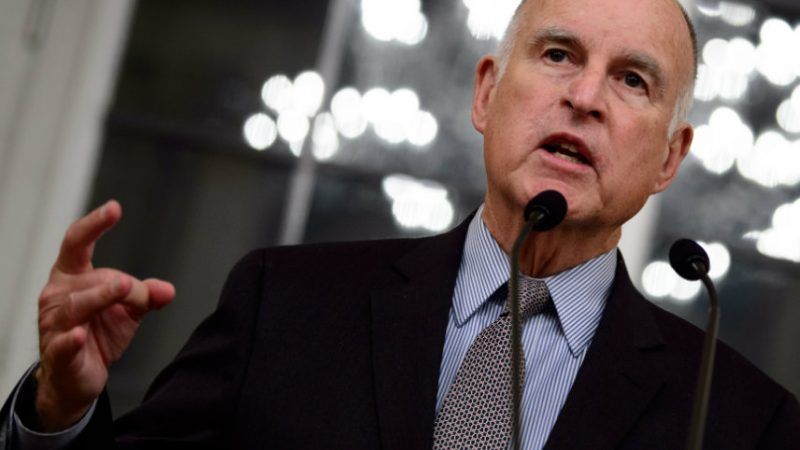California Lurches Left As Jerry Brown Heads Into the Sunset
For all his obvious flaws, Brown governed the state like an adult. What comes next is likely to be worse.

We've known this day was coming: the end of the Jerry Brown administration. For all of Gov. Moonbeam's flaws, those of us with conservative, libertarian or moderate leanings know that the state government is losing the last adult in charge. The next governor will be less willing to serve as a backstop against a Legislature that's gone far to the left.
It's why Republicans have been muted in their criticism even as Brown pushed the cap-and-trade plan, a high-speed rail boondoggle, and budgets that obliterated spending records. My main beef is Brown failed to use much of his political capital for a Nixon-goes-to-China moment that takes on the public-sector unions. They are the main obstacle to fixing various state problems, ranging from the pension system to the lackluster public schools.
A recent 90-minute gubernatorial debate in San Jose reminded us of what's coming. It also highlighted the new reality, which is driven by deep demographic and political changes, and exacerbated by the relatively new top-two system. Republicans are nothing but a sideshow in any statewide office now, and the choices usually come down to which variety of Democrat the state's voters prefer.
Lt. Gov. Gavin Newsom had the most entertaining line of the debate. NBC's Chuck Todd, the moderator, asked Newsom whether he thought the state's primary format would mean that two Democrats would face off in the general election. That top-two system creates a "jungle" primary where all candidates compete on the same ballot in the June primary contest, with the top two vote-getters moving on to the November race.
"You know my position, Chuck. A Republican would be ideal … and either one of these will do," Newsom said. The audience laughed because we all know that front-runner Newsom's main competition isn't from Republican Assemblyman Travis Allen, a boisterous Trump supporter in a state where Trump is synonymous with the plague, or GOP businessman John Cox. It's from former Los Angeles Mayor Antonio Villaraigosa, a fellow Democrat.
Indeed, the most interesting ad in the race so far has come from Newsom, who targeted Cox for his support of gun rights with this line: "John Cox stands with Donald Trump and the NRA." Many observers wondered why Newsom would slam a Republican candidate, but CBS noted that the ad highlights the "odd incentives" of the state's primary system. The ad seems designed to shore up Cox's support among Republicans, which might push him into the top two. Given the state's Democratic voter-registration imbalance, that would mean a cakewalk for Newsom.
The top-two system was the latest effort, passed by voters in 2010, to rejigger the election rules to improve political outcomes. Backers were concerned that party primaries usually benefited ideologically extreme candidates who appealed to each party's base. By opening up the primary to all voters, they figured that candidates would have to make a broader, more moderate appeal.
It likely helped Steve Glazer, a thoughtful, middle-of-the-road Democrat, win a Bay Area Senate seat. But the system also eliminated sharp political debates in general election races that increasingly feature two candidates from the same party who share few political differences. But even without "top two," this year's governor's race would likely have the same outcome. You can't change the leanings of the electorate by fiddling with the election system. The polls favor Newsom and the battle right now is for the second spot.
Newsom is an intelligent guy who did yeoman's work creating a blueprint for the state's marijuana legalization efforts. In 2016, columnist John Phillips, writing in the Orange County Register, called him a "Silicon Valley Democrat" who "isn't afraid to break away from big labor on issues like the bullet train, 'sharing economy' services such as Uber, or union-free charter schools, yet embraces the communitarian principles of environmental regulations and strict gun control."
Unfortunately, his zeal for gun control and embrace of single-payer health care is frightening. The latter is an enormous peril given that the Senate last year passed a hobbled-together scheme that would swamp the state budget by offering "free" health care to anyone who resides here. Newsom doesn't support that particular proposal, but any single-payer plan will threaten the budget, undermine the medical system and create pressure for tax increases.
For his part, Villaraigosa has a long history of calling for changes to 1978's tax-limiting Proposition 13. That measure, which caps property taxes at 1 percent of a property's sales price, has long been the "third rail" (you touch it and you die) of California politics. If he touches the rail and becomes governor, expect the rapid movement to a "split roll" (removing protections from commercial properties). He has been good on charter schools, though. The other Democratic also-rans are liberals of one flavor or another.
Strange as this sounds, those of us concerned about high taxes and government spending probably will miss the days of Jerry Brown.
Steven Greenhut is Western region director for the R Street Institute. He was a Register editorial writer from 1998-2009. Write to him at sgreenhut@rstreet.org. This column was first published in the Orange County Register.


Show Comments (64)